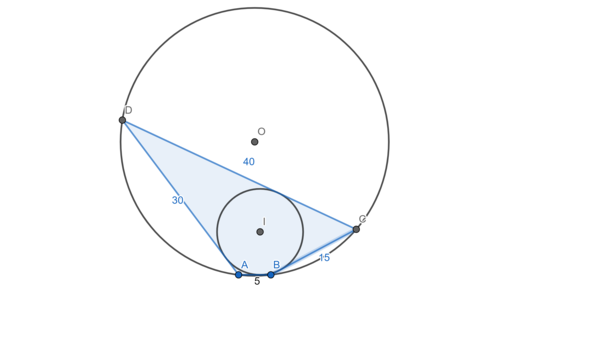Quadrilateral Circular Reasoning (Take 2)
If the largest side of a tangential and cyclic quadrilateral is 8 times longer than its smallest side, and its second-largest side is 2 times longer than its second-smallest side, and its area is 3 0 0 , then find its perimeter.
The answer is 90.
This section requires Javascript.
You are seeing this because something didn't load right. We suggest you, (a) try
refreshing the page, (b) enabling javascript if it is disabled on your browser and,
finally, (c)
loading the
non-javascript version of this page
. We're sorry about the hassle.
2 solutions
Nice solution! I'm also glad this problem worked.
Log in to reply
Yeah, it's nice how the properties of cyclic and tangential quadrilaterals complement each other.
Let the sides of the quadrilateral be a , b , c , d , where it can assumed without loss of generality that a > b > c > d > 0 . We know from the problem statement that
a = 8 d , b = 2 c , a + d = b + c
This system of equations has the following solution: ( a , b , c , d ) = t ( 8 , 6 , 3 , 1 ) , where t is an arbitrary positive real.
The area of the cyclic quadrilateral is given by Brahmagupta's formula
A = ( s − a ) ( s − b ) ( s − c ) ( s − d )
where s is the semi-perimeter, s = 2 1 ( a + b + c + d ) . Hence, s = 9 t , and
A = 3 0 0 = t 2 ( 9 − 8 ) ( 9 − 6 ) ( 9 − 3 ) ( 9 − 1 ) = t 2 ( 1 ) ( 3 ) ( 6 ) ( 8 ) = 1 2 t 2
Hence, t = 1 2 3 0 0 = 5
Therefore, s = 9 t = 4 5 and P = 2 s = 9 0

Say the quadrilateral has sides (in order) a , b , c , d . From the question, either b = 8 a and d = 2 c , or c = 8 a and d = 2 b (other cases are just rotations and reflections of these).
In tangential quadrilaterals, the two pairs of opposite sides have the same sum. So a + c = b + d = s , the semiperimeter.
If b = 8 a and d = 2 c , this is a + c = 8 a + 2 c
which has no solutions with all sides positive.
So c = 8 a and d = 2 b , and a + 8 a = b + 2 b
ie b = 3 a . Now we have all the sides in terms of a : b = 3 a , c = 8 a , d = 6 a
In cyclic quadrilaterals, the area is given by Bramhagupta's formula: K = ( s − a ) ( s − b ) ( s − c ) ( s − d )
Combining this with a + c = b + d = s gives K = a b c d in the case when the quadrilateral is tangential as well. Substituting for the sides as above, 3 0 0 = a ⋅ 3 a ⋅ 8 a ⋅ 6 a = 1 2 a 2
so a = 5 , b = 1 5 , c = 4 0 , d = 3 0 and the perimeter is 9 0 .